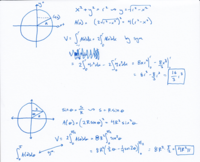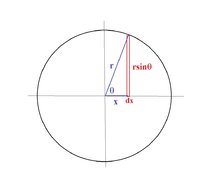Stewart, Early Transcendentals, 6.2, problem 54: find volume of solid - base S is a circular disc with radius R. Parallel cross-sections perpendicular to base are squares. I did it 2 ways, and got different answers. First one goes along with the chapter examples, and I think is fine. Second one (integrating with respect to angle theta) seems like it should work, but different answer. Where do I go wrong? thanks
You are using an out of date browser. It may not display this or other websites correctly.
You should upgrade or use an alternative browser.
You should upgrade or use an alternative browser.
stewart, 8th ed, problem 54
- Thread starter EJE12345
- Start date
need help with problem from Stewart's Early Transcendental's, 8th ed, 6.2.54. find volume of solid: base is disk with radius r, parallel cross-sections perpendicular to base squares. i have two solutions: first follows along with the ideas in the examples of the section, finding area of square as a function of point x on the circle, then integrating over 0 to the radius. the second solution i think it wrong but can't tell why - looking at the the area of the square as a function of the angle theta defined in the image, then integrating from 0 to pi/2. where am i going wrong? thanks


Your final answer is correct by coincidence because we are moving in a circle, but setting the integral is wrong.
if we let [MATH]2x[/MATH] be one side of the square, then its area is [MATH]4x^2[/MATH], then we have to take the height as [MATH]dy[/MATH], not [MATH]dx[/MATH], so the integral is
[MATH]V = \int_{-r}^{r} 4x^2 \ dy = 8\int_{0}^{r} r^2 - y^2 \ dy[/MATH]
if we let [MATH]2x[/MATH] be one side of the square, then its area is [MATH]4x^2[/MATH], then we have to take the height as [MATH]dy[/MATH], not [MATH]dx[/MATH], so the integral is
[MATH]V = \int_{-r}^{r} 4x^2 \ dy = 8\int_{0}^{r} r^2 - y^2 \ dy[/MATH]
i see, i got terms mixed up when transposing from a note book. so you agree the first answer is correct.
do you know why the method is incorrect, using trig functions instead?
i was a math major in college 20y ago, im relearning a lot of this just as a hobby, so i dont have a teacher/professor. the answer to my question may be apparent later as i go through the book. thanks for the help.
do you know why the method is incorrect, using trig functions instead?
i was a math major in college 20y ago, im relearning a lot of this just as a hobby, so i dont have a teacher/professor. the answer to my question may be apparent later as i go through the book. thanks for the help.
Dr.Peterson
Elite Member
- Joined
- Nov 12, 2017
- Messages
- 16,871
Stewart, Early Transcendentals, 6.2, problem 54: find volume of solid - base S is a circular disc with radius R. Parallel cross-sections perpendicular to base are squares. I did it 2 ways, and got different answers. First one goes along with the chapter examples, and I think is fine. Second one (integrating with respect to angle theta) seems like it should work, but different answer. Where do I go wrong? thanks

The element of volume is not given by \(A(\theta)d\theta\); the thickness of a slice is not \(d\theta\).
Have you learned anything about integrating in polar coordinates?
skeeter
Elite Member
- Joined
- Dec 15, 2005
- Messages
- 3,204
[MATH]x = r\cos{\theta} \implies dx = -r\sin{\theta} \, d\theta[/MATH]
[MATH]dA = (2r\sin{\theta})^2[/MATH]
[MATH]V = \int_{\pi}^0 (4r^2\sin^2{\theta})(-r\sin{\theta}) \, d\theta[/MATH]
note ... rotating [math]\theta \text{ from } \pi \to 0 \implies dx > 0[/math]
[MATH]V = 4r^3 \int_{\pi}^0 (1-\cos^2{\theta})(-\sin{\theta}) \, d\theta[/MATH]
[MATH]u = \cos{\theta} \implies du = -\sin{\theta} \, d\theta[/MATH]
[MATH]V = 4r^3 \int_{-1}^1 (1-u^2) \, du = 4r^3 \bigg[u - \frac{u^3}{3}\bigg]_{-1}^1 = 4r^3\bigg[\frac{2}{3} - \left(-\frac{2}{3}\right)\bigg] = \frac{16r^3}{3}[/MATH]

[MATH]dA = (2r\sin{\theta})^2[/MATH]
[MATH]V = \int_{\pi}^0 (4r^2\sin^2{\theta})(-r\sin{\theta}) \, d\theta[/MATH]
note ... rotating [math]\theta \text{ from } \pi \to 0 \implies dx > 0[/math]
[MATH]V = 4r^3 \int_{\pi}^0 (1-\cos^2{\theta})(-\sin{\theta}) \, d\theta[/MATH]
[MATH]u = \cos{\theta} \implies du = -\sin{\theta} \, d\theta[/MATH]
[MATH]V = 4r^3 \int_{-1}^1 (1-u^2) \, du = 4r^3 \bigg[u - \frac{u^3}{3}\bigg]_{-1}^1 = 4r^3\bigg[\frac{2}{3} - \left(-\frac{2}{3}\right)\bigg] = \frac{16r^3}{3}[/MATH]

First, I apologize to you because I was wrong. Your set up for the first integral is correct. I have just realized that you have used [MATH]2y[/MATH] for one side of the square instead of [MATH]2x[/MATH] which is also correct.i see, i got terms mixed up when transposing from a note book. so you agree the first answer is correct.
do you know why the method is incorrect, using trig functions instead?
i was a math major in college 20y ago, im relearning a lot of this just as a hobby, so i dont have a teacher/professor. the answer to my question may be apparent later as i go through the book. thanks for the help.
To do this in trigonometry is very easy. You can follow skeeter way, or you can continue with my integral.
Last time, we had this integral,
[MATH]V = \int_{-r}^{r} 4x^2 \ dy = 8\int_{0}^{r} r^2 - y^2 \ dy[/MATH]
Change the variables to polar coordinate.
[MATH]y = r\sin\theta[/MATH][MATH]dy = r\cos\theta \ d\theta[/MATH]
The integral will become,
[MATH]V = 8\int_{0}^{\pi/2} (r^2 - r^2\sin^2 \theta) (r \cos \theta) \ d\theta = \frac{16r^3}{3}[/MATH]
Can you figure out why we chose the limit of integration as [MATH]0\leq \theta \leq \frac{\pi}{2}[/MATH]?
